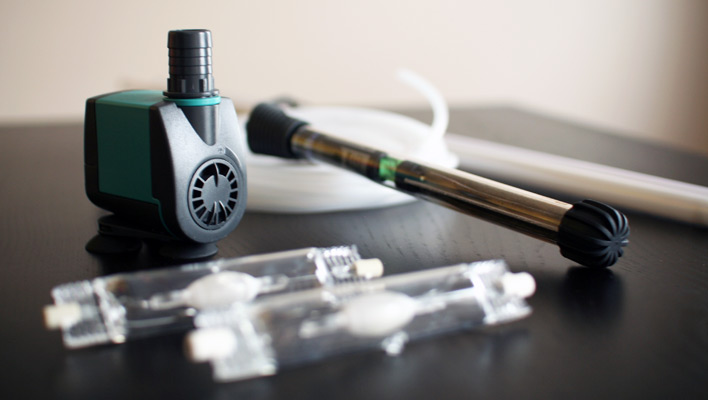According to Kurtz’s Law, the likelihood of a key aquarium component breaking down and leaving you and your livestock in the lurch varies inversely with your local fish store’s business hours.
Okay, so I totally fabricated that law, and I’m not even sure it actually makes any sense. But as all you experienced salties out there know, aquarium equipment has the aggravating tendency to fail at the most inopportune times—such as when your local fish store has just closed for the night and you’re scheduled to depart the next day for a month-long trip. That’s why it’s so important to keep replacements on hand for your most critical system components.
Here are the spares that we recommend you have available:
Heater
Your heater puts the “tropical” in “tropical marine aquarium.” If it should fail, your water temperature can quickly drop below the desired range, stressing your livestock, so it’s always wise to have a replacement heater of the same wattage on hand.
Don’t worry; it doesn’t have to sit idle when there’s no emergency. You can use it to heat the clean salt water you mix up in preparation for water changes.
Sump pump
If vital elements of your aquarium’s life-support system—your protein skimmer, heater, etc.—are contained within a sump below your tank, then there’s a lot riding on the proper function of your return pump. Think of it as the heart of your aquarium’s circulatory system. Don’t be caught without a spare in the event of a failure!
Like your spare heater, your extra pump can be put to good use circulating makeup saltwater when it’s not needed for an emergency in your main system. A quality sump pump can be costly, so if money is tight, you might want to explore the option of buying a used one from a known reliable source.
Light bulbs/tubes
If you have a fish-only system and a light bulb or tube burns out, it’s no big deal if you have to wait a few days for the replacement to arrive. However, lighting plays a crucial role in reef tanks housing photosynthetic invertebrates, so it’s always wise for reef keepers to have spare lamps on hand.
Again, cost can be an issue here because reef-quality lamps don’t come cheap. Buying brand new lamps to keep in reserve for emergencies may not be realistic for many hobbyists. My solution to this dilemma is to set aside my aging—yet still functioning—metal halide lamps and fluorescent tubes when I replace them with new ones on an annual basis. They may no longer produce the ideal level of light intensity, but in the event that one or more lamps should burn out, the old ones will certainly get my corals by until replacements arrive.
Miscellaneous parts
Here I’m referring not to a single major aquarium component, but to the various minor parts—hoses, tubing, clamps, o-rings, impellers, etc.—that keep the major ones operating properly, prevent leaks, and so forth. These items, while vital to operation, are generally inexpensive, so buying extras is a no-brainer.
What’s in your spare-parts kit?
If you have an item in your spare-parts kit that’s not listed above or you have an anecdote about a spare component saving your proverbial skin, please tell us about it in the comment section below!




I think these are great tips; to keep spare parts on hand in case a part like a pump were to go out when the store is closed. I’m glad to have found a listing of all the parts so I can make sure I have them in my spare parts kit when I need to make a repair on the spot. Thanks for the aquarium advice.